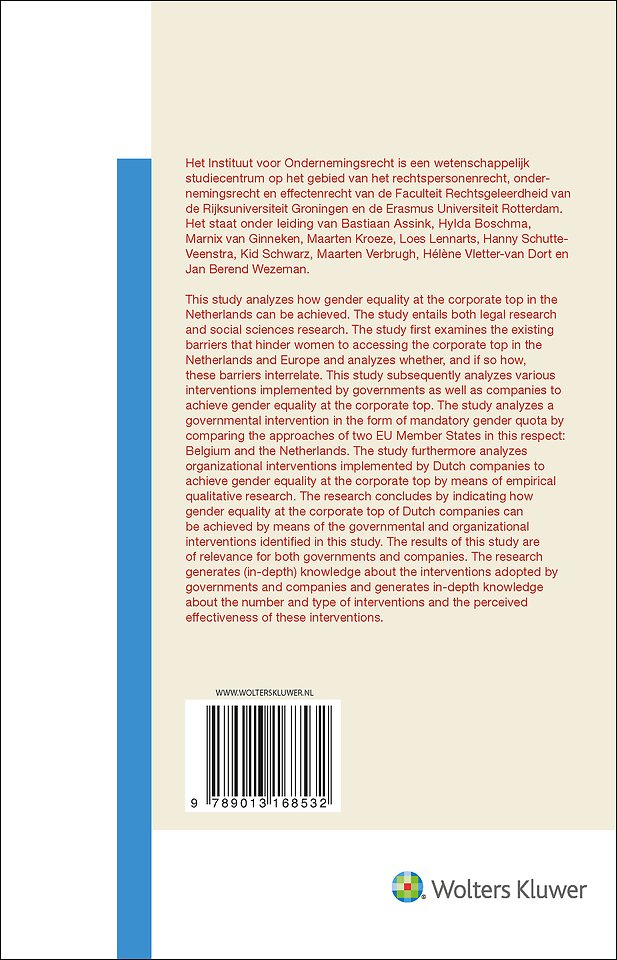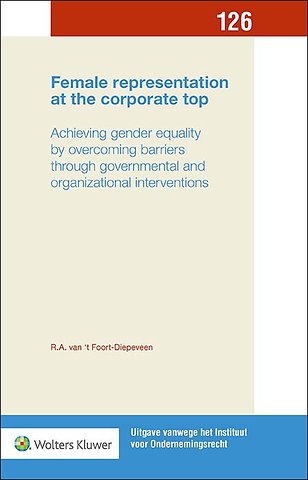Female representation at the corporate top
Samenvatting
This study analyzes how gender equality at the corporate top in the Netherlands can be achieved, from both a legal research and social science perspective. The author provides a comprehensive analysis of the underlying barriers and puts forward potentially fruitful governmental and organizational interventions.
How can gender equality at the corporate top in the Netherlands be achieved? What barriers currently hinder women from accessing the corporate top in the Netherlands and Europe? And to what extend do these barriers interrelate? The PhD dissertation Female representation at the corporate top critically examines these issues, adopting a multidisciplinary approach consisting of legal research and social sciences research.
Not only does the study provide an accessible analysis of the barriers that underly gender inequality at the corporate top, but the author also puts forward the building blocks for successful future interventions. As a result, the publication is of relevance for scholars, governments and companies.
Gender equality interventions
The PhD dissertation highlights (in-depth) knowledge about the interventions, as well as the perceived effectiveness of these interventions. Firstly, a governmental intervention in the form of mandatory gender quota is examined by comparing the approaches of two EU Member States in this respect: Belgium and the Netherlands. In addition, the author analyzes various organizational interventions implemented by Dutch companies to achieve gender equality at the corporate top by means of empirical qualitative research.
By connecting in-depth analyses with practical case studies, the reader will gain a deeper understanding of how gender equality at the corporate top of Dutch companies can be achieved by means of the governmental and organizational interventions.
Trefwoorden
Specificaties
Inhoudsopgave
Acknowledgements VII
List of abbreviations and acronyms IX
Chapter 1: Introduction 1
1.1 Background and research context 1
1.2 Scope and aims of the research 6
1.3 Relevance of the study 7
1.3.1 Theoretical lens 7
1.3.2 Academic relevance 9
1.3.3 Practical relevance 11
1.4 Research objective and research questions 12
1.5 Definitions of key concepts 14
1.5.1 Corporate top 14
1.5.2 (Dutch) Companies 15
1.5.3 Gender equality and women’s underrepresentation 15
1.5.4 Governmental and organizational interventions 16
1.6 Methodology 17
1.7 Reading guidance 20
Chapter 2: Barriers to women’s advancement to the corporate top in Europe 23
Abstract 23
2.1 Introduction 24
2.2 Theoretical framework and concepts 26
2.2.1 Liberal feminist lens 26
2.2.2 Corporate top 27
2.2.3 Women’s representation 27
2.3 Methodology 28
2.3.1 Planning of the review and formulating the research question 28
2.3.2 Searching for relevant articles and assessment of the relevance and quality of the articles found 28
2.3.3 Analysis and synthesis of the findings 29
2.4 Barriers to women’s advancement to the corporate top and their interrelatedness 31
2.4.1 Psychological processes 31
2.4.1.1 Gender stereotypes 31
2.4.1.2 Bias in selection/performance appraisal 33
2.4.2 Devaluation of women by others and by themselves 34
2.4.3 Career preferences 34
2.4.4 Organizational culture and organizational processes 36
2.4.5 Work-family balance/work-family conflict 37
2.4.6 Professional support 39
2.4.6.1 Exclusion from networks 39
2.4.6.2 Lack of access to mentors 40
2.4.6.3 Lack of role models 40
2.4.7 Leaky pipeline 40
2.4.8 Overview of the barriers 41
2.5 Discussion and concluding remarks 42
2.6 Limitations and recommendations for future research 45
Chapter 3: Gender quotas for corporate boards: a comparison between Belgium and the Netherlands 47
Abstract 47
3.1 Introduction 47
3.2 Belgium 52
3.2.1 Legislative history of introducing gender quota 52
3.2.2 Gender provision in the Belgian Corporate Governance Code 53
3.2.3 Quota legislation 54
3.2.4 Progress in the number of women on corporate boards 57
3.2.4.1 Figures 57
3.2.4.2 Effectiveness of quota legislation in terms of progress in the number of women on corporate boards? 59
3.2.5 Reflection 60
3.3 The Netherlands 61
3.3.1 Legislative history of introducing a target figure and gender quota 61
3.3.2 Gender provision in the Code 64
3.3.3 Balanced representation men and women – 2013-2020 64
3.3.4 Progress in the number of women on corporate boards 67
3.3.4.1 Figures 67
3.3.4.2 Effectiveness of the target figure in terms of progress in the number of women on corporate boards? 70
3.3.5 Proposed binding quota – 2020 70
3.3.6 Reflection 75
3.4 Comparison – similarities and differences 76
3.5 Discussion and conclusion 78
Chapter 4: Justifications of Dutch listed companies for gender equality and gender diversity and an assessment of certain aspects of companies’ diversity policies 81
Abstract 81
4.1 Introduction 82
4.2 Literature review on gender diversity in boards: the economic decision-making perspective 84
4.3 A rights-based perspective on gender diversity in corporate boards 87
4.3.1 Gender equality covered by international treaties 88
4.3.1.1 General UN treaties 88
4.3.1.2 CEDAW 88
4.3.1.3 The CEDAW Committee on the Dutch government’s (lack of) compliance 89
4.3.2 EU legislation 91
4.3.3 Gender equality law in the Netherlands 93
4.3.4 Summary 96
4.4 Methodology of the empirical studies in 2014 and 2015 97
4.4.1 Research methodology 97
4.4.2 Research population 99
4.5 Analysis of the results of the empirical Nyenrode studies I and II 100
4.5.1 Analysis of the findings of the Nyenrode Study I 100
4.5.2 Analysis of the findings of the Nyenrode Study II 105
4.6 Concluding remarks 112
Chapter 5: Organizational interventions towards achieving gender equality at the corporate top 117
Abstract 117
5.1 Introduction 118
5.2 Theoretical framework 119
5.3 Method 120
5.4 Findings 125
5.4.1 Per case analysis 125
5.4.1.1 Prof.ServicesCo 128
5.4.1.2 ChemiCo 129
5.4.1.3 ITCo 130
5.4.1.4 InsuranceCo 131
5.4.2 Cross-case analysis 132
5.4.2.1 Types of interventions 132
5.4.2.2 Barriers 133
5.4.2.3 Results of interventions 134
5.4.2.4 Factors contributing to an increase in the number of women on boards 136
5.4.2.4.1 Commitment from the top and tone at the top 136
5.4.2.4.2 Supportive organizational culture 137
5.5 Discussion and conclusion 137
5.6 Implications, research limitations and future research 141
Chapter 6: Conclusion 143
6.1 Conclusion 143
6.2 Conclusions of the sub-studies 144
6.2.1 Barriers to women’s advancement 144
6.2.2 Governmental interventions in the form of quota 146
6.2.3 Companies’ justifications for having women on their boards and assessment of certain aspects of companies’ diversity policies 148
6.2.4 Gender equality organizational interventions 150
6.3 Main research question 152
6.3.1 Barriers identified in Chapter 2 in relation to interventions 154
6.3.2 Barriers identified in Chapter 5 in relation to interventions 158
6.3.3 Interventions that could not be linked to barriers 159
6.3.4 Additional interventions 161
6.3.5 Conclusion barriers and interventions and response to main research question 162
6.3.6 Findings in relation to liberal feminism 163
6.3.7 Practical implications of the study 163
6.4 Limitations of the research 164
6.5 Recommendations for future research 164
Summary 167
Samenvatting 171
Bibliography 175
Anderen die dit boek kochten, kochten ook
Rubrieken
- cadeauboeken
- computer en informatica
- economie
- filosofie
- flora en fauna
- geneeskunde
- geschiedenis
- gezondheid
- jeugd
- juridisch
- koken en eten
- kunst en cultuur
- literatuur en romans
- mens en maatschappij
- naslagwerken
- non-fictie informatief/professioneel
- paramedisch
- psychologie
- reizen
- religie
- schoolboeken
- spiritualiteit
- sport, hobby, lifestyle
- thrillers en spanning
- wetenschap en techniek
- woordenboeken en taal









